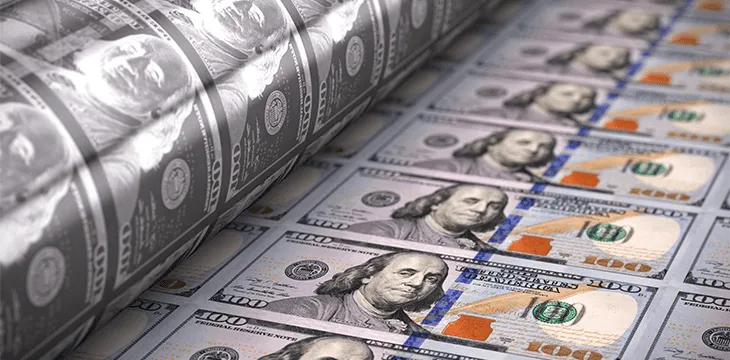|
Getting your Trinity Audio player ready...
|
This post originally appeared on the ZeMing M. Gao’s website, and we republished with permission from the author. Read the full piece here.
It is important to make a distinction between “money” and “currency,” not for the sake of semantics but to have a clear way to conceptualize the whole matter. I used to think it was a trivial distinction, but started to more and more realize its importance.
Definitions of money and currency
Money: Money is an agreement between two parties for value exchange without direct bartering. Money is value agreement.
Currency: If we standardize these money agreements into an easily transmissible and countable form using a certain technology, we have a currency. Currency is technology.
If money were a thought, currency would be language (and language is a form of technology).
Concerning money, Ludwig von Mises’ theory of money and credit got it right fundamentally, and the majority of economists were wrong, and still are.
However, Mises focused on the profound concept of money itself and did not focus on the distinction between money and currency.
Money is an agreement of value, while currency is technology that standardizes money. Because in most cases, they are very hard to separate, people tend to think that they are conceptually the same thing. They’re not.
At the conceptual level, we should not confuse the legality of money with the definition of money. The government can decree certain money as the “legal tender,” but being a legal tender is not a requirement for something to be money, as money is value agreement among parties purely in the context of trading. Becoming a legal tender would be a useful goal of any form of money, but on the other hand being a legal tender is not part of the definition of money, nor a characteristic of “good money.”
Likewise, we should not confuse the morality and quality of money with the definition of money. There are good money and bad money. Fiat money is bad money if Mises is right (which he is), but technically still money, because it is an “agreement of value,” only that the agreement is forced upon people by a sovereign, instead of market-based agreement. And fiat money is almost always also currency, because the government always finds a way to standardize its fiat money into a usable currency.
Mises in “The Theory of Money and Credit” said: “…those goods that were originally the most marketable became common media of exchange.” This was subsequently interpreted to mean that Mises defined money as the most marketable commodity (See “Mises on Money” by Gary North). But Mises made the statement in a narrow context of discussing commodity-based money (versus credit-based money). He did not mean to give a definition of money in that context.
From an inclusive viewpoint, there are two major categories of money:
Thing-based;
Derivative-based.
Note that I intentionally did not use “commodity-based” for the first category “thing-based,” nor “credit-based” for the second category “derivative-based.”
“Commodity” is a special category of “goods,” which in turn is a sub-category of “things,” which may not only include goods but could also include services, as well as data, which could be either characterized as goods or services. This is also why I did not use “asset-based,” because in today’s accounting, services are not considered as assets (although service revenues are added to asset accounts), mostly due to their lack of transferability. However, with the rise of machine economy and data economy, more and more things that are not goods but are becoming transferable, and therefore have the potential to be a thing-based money.
In addition, commodity is standardized goods—not only standardized in terms of the quality and quality of the goods themselves, but also standardized in terms of contracts. Therefore, in this sense, commodity-based money has already moved toward becoming a currency, which by definition is a technology that standardizes money.
Likewise, given a broad definition of a “derivative” as a value contract based on an underlying thing (a good, an asset, or even a service), “credit” is a special type of a derivative, and therefore “credit-based” is a subcategory of “derivative-based.” They are essentially the same in most applications today, because few derivatives, if any at all, are used as money. However, this is due to the limitation of technology, not an inherent conceptual limitation. With the rise of blockchain, Bitcoin and smart contracts, more derivatives may serve as a medium of exchange without being directly based on a credit.
Redeemable notes, and all fiat money belong to the category of “derivative-based money.”
Mises said that there are four kinds of money: token (base metal) coins, commodity money, credit money, and fiat money. But conceptually, base metal belongs to the category of thing-based money, and “coins” is really in the category of currency instead of just money; and fiat money belongs to the category of derivative-based money, except that the “value contract” for the derivative in fiat money is created and enforced by a state instead of by market participants according to voluntary market agreements. Fiat money is also credit-based money, except it is a special sovereign credit rather than private credit.
It is clear that defining money as an agreement of value provides a more approachable and manageable basis for conceptualization than defining money as the most marketable commodity. The former does not contradict the latter but includes it. The former includes both thing-based money and derivative-based money, while the latter includes only commodity-based money (which is a subcategory of thing-based money) and may have a potential to blur the distinction between money and currency.
The above definition of money is broad and neutral, and does not in itself imply any form of money satisfying the above definition being superior.
However, it should be noted that Austrian school of economics believes that commodity money is the proper money.
At the current stage, Bitcoin (BSV) can already serve as a currency (i.e., a technology that is used to standardize and transmit the existing money, the US dollar especially), but it is not money yet.
But when people actually buy Bitcoin for productive purposes, for example to build STAS tokens (rather than for speculative reasons), Bitcoin is a real commodity, which is the first giant step toward becoming money.
Gresham’s law is a mischaracterization
Gresham’s law is a monetary principle stating that “bad money drives out good.”
With a clear distinction between money and currency, however, it should be quite evident that Gresham’s law, although a true phenomenon, is a mischaracterization. What Gresham’s law describes is really the following:
“A more efficient currency always drives out the less efficient one.”
To the extent that a cheaper coin (e.g., one that has less precious metal content) is effectively recognized as a representation of the same monetary value as a more expensive coin, it is a more efficient currency, because it is a less costly standardization of the same amount of money, hence a better technology. Therefore, it is natural to expect that people would be more inclined to spend the cheaper coins.
Therefore, the real problem with fiat money is not that bad money drives out good money, but that the government is cheating on the monetary value that defines the money itself by taking advantage of cheaper and more efficient technology. In other words, the government prints/mints more money than it should. But this does not have to be the case if the government is honest.
But if the government cannot be trusted to be honest, that is a different matter.
Fix the value agreement (money), not the technology (currency).
The origin and qualities of money
Any time when a value exchange occurs without direct bartering1, parties need to agree upon another medium. The medium that the parties agreed upon is money. The medium that can serve as money needs to have two very basic characteristics:
(1) has a readily recognizable value in order to compare the value of the goods and the value of the medium, such that the value exchange between the goods and the medium is considered a fair trade when both sides accept that the values are comparable; and
(2) has a relatively stable value, because the party that accepts the medium needs to keep the value for future use (i.e., to trade for something the party actually needs).
The above first quality is often called “unit of account.” But it should be noted that Austrian school of economics does not recognize objective value that can be quantitatively measured, but only subjective value that can be ranked. Therefore in the most basic sense, money does not need to have a quantitative objective unit of account, but just need to have a subjective value that can be compared to that of the goods being exchanged.
The above second quality is often called “the store of value.” But it does not necessarily mean long-term durable value-preserving store of value, much less a value-appreciation prospect. As a basic function of money, it just needs to be able to keep the value for the next transaction to a degree that its holder finds it satisfactory.
Money does not have to be standardized as a currency in order to be money. Money can be local, provisional (ad hoc or improvised) and nonstandardized but still remains money, albeit this form of money is clearly not very desirable. Conversely, although a currency is always the standardization of a certain money, the currency itself does not have to become money first in order to then become a currency. It may just standardize an existing money and serve as the currency of that money. Currency is technology.
If money is credit-based, there is always an issue of credibility. A village baker issuing a private redeemable note to neighbors needs to have actual goods (bakery) to back up the note he issues. If he has won the trust of the community, he does not need a third party as a guarantor nor another asset as a collateral. But if he doesn’t have enough credit in the community, he might need other things to back up his notes. The same is with a government. If the government has high enough credit to the public, it can issue a government note (e.g., a central bank note) without another guarantor nor another asset as a collateral. But if it does not have that kind of credit, it may need another thing to back up its notes. And the fact that a government can be abusing the credit it has earned in the past is a different issue.
Unit of account and store of value are therefore the most basic characteristics of money.
Other features such as fungibility, durability, stability, recognizability, portability, divisibility, malleability, uniformity, limited supply, etc. are not required characteristics of the fundamental definition of money. These qualities are more related to currencies, instead of money. They may be desired qualities of commodity money, but this is only because commodity-money is already quite close to a currency, and would be a currency if standardized using technology.
The origin and qualities of currency
If a certain type of technology is used to standardize money, we have a currency.
In this sense, even coin minting and paper notes printing are a type of “technology” for standardizing money as a currency. So are digital systems used by banks create digital currencies.
An introduction of a new technology to create a better currency does not necessarily introduce a new money. It may, but it does not have to, because money and currency are two different concepts.
For example, in the modern monetary systems, banks create money, not just currency. When a bank creates new money, it really creates new units of credit-based money. This is what the banks actually do, but not what banks must do. In theory at least, banks don’t have to create new money. Their job can be just creating currencies by applying an available technology (digital currency is one example). But in reality, banks create money, not just currency. Banks create money using fractional reserves (leveraging). They do this for a very simple reason: to maximize profits.
This distinction between money and currency is very basic but important in the context of bitcoin and cryptocurrencies.
For example, Bitcoin was firstly introduced as a “digital thing” the ownership of which can be securely transferred from one party to another (1) without making a copy of the “digital thing”; and (2) without relying on the third party. In this sense, it is a merchandise that can be owned and traded in the most basic sense. If it is created for the sake of obtaining the thing itself and have access to its intrinsic value/utility, it is a good or a commodity (because it is a standardized good). But if it is traded as an exchange medium to avoid direct bartering, it is money in a narrow context of those traits. However, because it possesses such qualities as fungibility, recognizability, portability, uniformity, limited supply, etc., it can easily serve as a currency (i.e., a technology of money). It was clearly an objective of the original Bitcoin to become a currency. It was even named “a peer-to-peer cash system” at its birth. In its original form or its present form, it is not a new form of money in a broader sense, yet. It is just a better technology (i.e., a new and better currency) that can be used to better transfer existing money (measured by US dollars, or any other fiat currencies, which are both money and currency).
In other words, Bitcoin is initially a new language that expresses the existing monetary thoughts.
Bitcoin’s path to become money
Bitcoin can become money in the future. For that to happen, it firstly needs to become a widely traded commodity.
When Bitcoin is used as method to transmit value measured in another form of money (e.g., fiat money), or as a settlement medium to exchange value measured in another form of money, it is a currency.
It is possible that Bitcoin may never become money in the real sense even if it becomes widely used, because it may be used as a currency only, regardless of how prevalent its use is, even globally.
However, Bitcoin would become money when its value is no longer measured by any other forms of money but instead serves as an independent unit of account and store of value directly in value transfers. This is most likely to take place first in virtual worlds in which bitcoin is the native money and currency used for the exchanges of virtual goods. But this may become interesting because it is quite possible that in the virtual worlds, product-related tokens might become local currencies when bitcoin itself has become money recognized across different platforms. This is already happening, albeit only on small scales, in esports such as CryptoFights.
Bitcoin’s path to become money would also satisfy the regression theorem of money. It first starts to be used as money based on its intrinsic value (e.g., people buy Bitcoin on market in order to make things, such as to create a micro-business, like a cash flow-generating word definition entry by SLictionary.com) rather than its speculative value, but gradually evolves into an abstract form of money based on a history of memory. When this happens, the value of money as a unit of account can have a degree of separation from its intrinsic value.
But according to regression theorem of money, a commodity money must start with a real intrinsic value, which Bitcoin SV (BSV) has when it is used for real utility functions, but BTC does not have because it lacks any utility other than speculative trading.
NOTE:
[1] Sometimes the lack of an apparent exchange medium may create an illusion of direct bartering. For example, exchange-facilitated crypto trading can enable direct trades between two different crypto assets without an involvement of a third assets. This can be the case with either central exchanges or decentralized exchanges. But a closer look will reveal that none of these traded crypto assets have really attained a status of money, even in the narrow sense of those particular trades. This is because, behind the scenes, it is the liquidity-providing and efficient machine-aided arbitraging that help to hide the real medium of exchange, which is always a fiat money, typically acting through a so-called stablecoin. Even though the trades of the crypto pairs may happen directly without an apparent involvement of a stablecoin, the reality is different. It is the technology that hides the fiat money. From a fundamental viewpoint of a unit of account, the fiat money is still the medium of exchange in crypto trading today. This is due to the fact that none of the so-called cryptos has the requisite qualities of money, and they will never attain a status of money, unless they acquire real utility-based values beyond pure speculative values.
Watch: Dr. Craig Wright’s keynote speech “Set in Stone: What is a Commodity?” at the CoinGeek New York Conference
https://www.youtube.com/watch?v=xxbCgMdk5Q8

 07-05-2025
07-05-2025 





